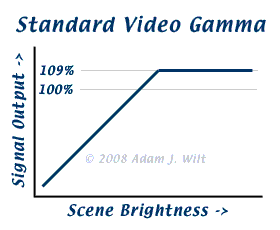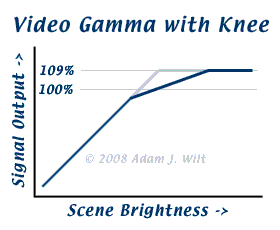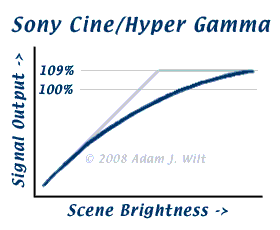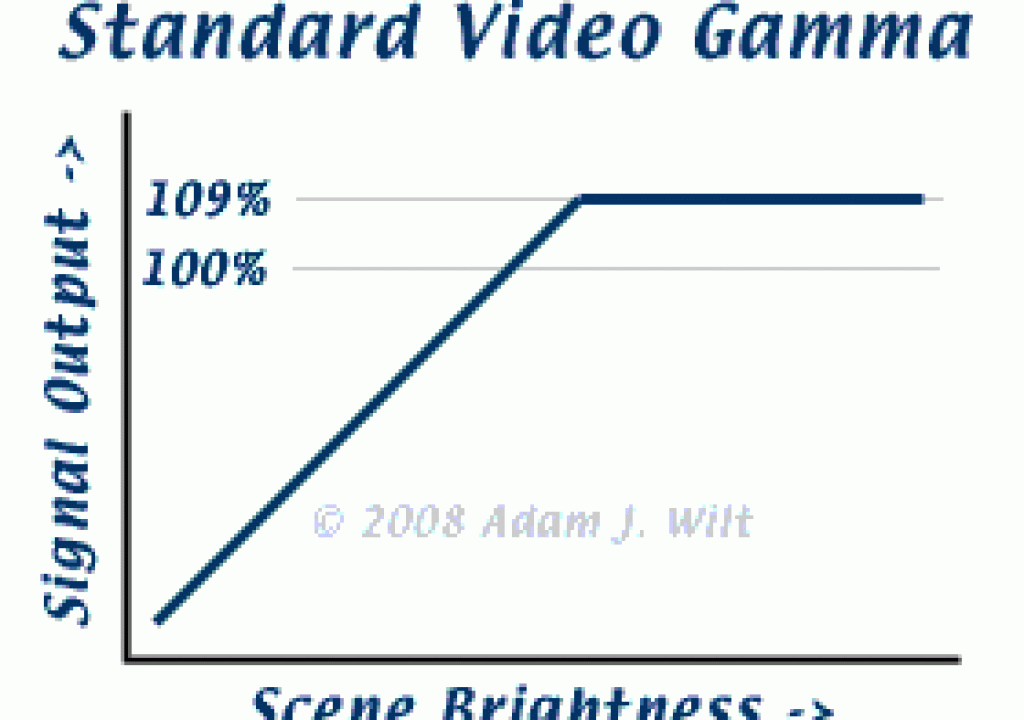When I reviewed the Sony PMW-EX1 camcorder, I raved about its cine gamma settings, derived from the hypergamma curves in the F23, F900/R, and various XDCAM HD ‘corders. The email I’ve been getting indicates that my enthusiasm isn’t universal. Let’s explore the issue a bit further.
Capturing a pleasing yet wide-ranging tonal scale on video is a bit of a challenge. Traditional video gamma settings render a “linear” look, in which the perceived contrast on screen closely matches the perceived contrast of the same scene in real life (OK, that’s an oversimplification, but bear with me here). That works fine, up to a point: the point where the video hard-clips at a brightness, in the digital domain, of about 109%.

Video cameras typically ameliorate the harsh clipping with a knee, a flattening of the contrast above a certain point. The knee does two things by flattening the contrast curve: it allows the capture of somewhat brighter values before the video hard-clips at 109%, and it lessens the nastiness of that crash by allowing more of a “hard handing” instead of a “hard crash” when scene brightness approaches the clipping level.

Sony’s Cine gamma (or Hyper gamma) curves try to emulate the more gradual, nonlinear “shoulder” of film, so the gamma curve starts flattening out earlier, and rounds off instead of having a distinct knee point. There’s no hard crash, nor even a hard landing, rather the bright parts of the scene softly roll into featureless white overexposure at the clipping level.

Here’s the problem: the cine gamma round-off and the associated smooth desaturation set in at a comparatively low level, say, around 80%. But you’ll often have skintones at or above that level; skintone highlights will often reach up into the mid-90s.
With a normal knee, the entire skintone range (short of specular highlights and glare) is usually within the linear part of the tonal scale, so faces retain a warm, saturated, natural look. Overexposed highlights intruding into the knee area will show strong tonal compression, but if your knee point is set up in the high 90s or so, the affected area will be fairly small. Also, most knees don’t do much with saturation; what typically happens is that overexposed areas start clipping in one or more colors, so skin typically goes a bit yellow just before blowing out completely. It’s a look we’re all very familiar with.
If you use Sony’s cine gammas on those same faces, and keep the same levels, more bright areas of the face (or other skin areas) will show some tonal compression and some desaturation. As the compression sets in a bit earlier, more of the face will be flattened and desaturated: by comparison to the “standard” look, skintone highlights aren’t as vibrant and contrasty and colorful. Faces can look a bit wan and washed out, without that ruddy, saturated,”glow of good health”.
(I should mention here that most of the Cine gammas depress midtones without changing exposure, so that skin tones will often be low enough to avoid the compressed region. But for video use, you’ll either need to pull those midtones up in post or increase the exposure to put the skintones back where we’re accustomed to seeing them. The former can’t be counted on unless you are the editor, and the latter just brings the faces up into the compression zone again.)
In isolation, I find that the cine gamma look is a bit more “true to life”; it handles overexposure more gracefully, and IMHO looks a little bit more like the way film handles highlights. But when compared to the standard gamma, yes, faces don’t look as good, at least as long as you avoid overexposure.
And let’s face it, faces are important. If you’re shooting people and pretty much putting their skin tones throughout the upper half of the tonal scale, you may very well prefer using the linear standard gammas with a sharp knee affecting only the very brightest bits of the picture.
I’ll be doing more detailed side-by-side tests with the various gammas with a bunch of folks in two weeks, so I’ll have some good examples to post, as well as more discussion of the tradeoffs of the different gammas and knees. But for now, just be aware that the cine gammas I was so effusive about aren’t necessarily right for all subject and all situations. For example, you might use cine gammas to keep a naturalistic sky when shooting establishing shots outdoors with uncontrolled, contrasty light, but switch to a standard gamma just for the close-ups, where the attention is focused on the face.
And as always, don’t take my word for it, or anyone else’s: test it for yourself and form your own opinion—and post that opinion here, so we can all learn from it.


